Most DJs start small and often with a smaller investment when it comes to buying DJ controllers. Many DJs also remember the night when they played for the very first time on one of the larger DJ consoles/mixers, with sweat dripping from nervousness. For some, it may have been the first time at a nightclub, bar, or at a friend's place, who might already have a mobile disco set up. With this guide, we aim to tell you about the advantages and disadvantages of transitioning from a small to a large DJ mixer console, recommendations for choosing DJ controllers, and the responsibilities that come with playing at venues such as nightclubs or corporate events.
Overall advantages of switching to a larger DJ controller
Overall, there are always advantages to transitioning from a small DJ controller to a larger one. With a larger DJ controller, you have several advantages, including:
- More control and more buttons - allowing you to have greater control over the music you play.
- It typically has more inputs and outputs. This allows you to connect more devices and sources to your setup, for example, if you are operating as a mobile disco.
- Faster software, which quickly reads your music with incredibly fast loading times. This provides a smoother flow when you're playing.
- Greater comfort - more space to work with. It becomes easier for you to mix and manipulate your music in a more natural and intuitive way.
- Longer durability. A larger DJ console will often be built of stronger materials - robust construction. Resistant to wear and tear.
- If we take the contrast between a Pioneer DJ DDJ-200 or DDJ-FLX4 and a complete console with two Pioneer DJ CDJ-3000 players including a Pioneer DJ DJM-A9 mixer connecting the two players, there is a huge contrast in what each can do.

As you can also see in the pictures, the first thing you'll notice is the size, but also the number of buttons. Don't worry, it shouldn't scare you away. The large one with CDJ-3000 players and DJM-A9 mixer can do more things and has significantly more features than a DDJ-200, but the starting point for being a DJ will always remain the same.
Beginner console
DDJ-200
Taking a specific look at the DDJ-200, it is an excellent DJ mixer to start with as it can be connected via your iPhone, where you can learn to play using a free app (WeDJ) with the help of a tutorial function. You just need to connect your iPhone to your DDJ-200 and from there, you can mix your songs from, for example, iTunes/Music. The mixer also comes with a quick start guide showing you how to set up the DJ controller with WeDJ and Rekordbox.

Additionally, the DDJ-200 has several functions and advantages such as:
- Number of channels: 2
- Easy to transport: Weighs only 1.2 kg.
- Touchpads and effects
- Transition FX
- Bluetooth 4.2 (Only for WeDJ App)

Disadvantages:
With this console, you are forced to use a split cable to separate audio output from smartphone or PC, so you can have audio output to headphones and external monitors. This way, you can check the sound in the headset when using the que button for the next track, while guests can hear the master output from the speakers.
DDJ-FLX4
Taking another look at a beginner console, which is also more suitable for a new DJ, as it also has a master output, so you can get a feel for what it's like to play out as a DJ, the DDJ-FLX4 is a fantastic choice.
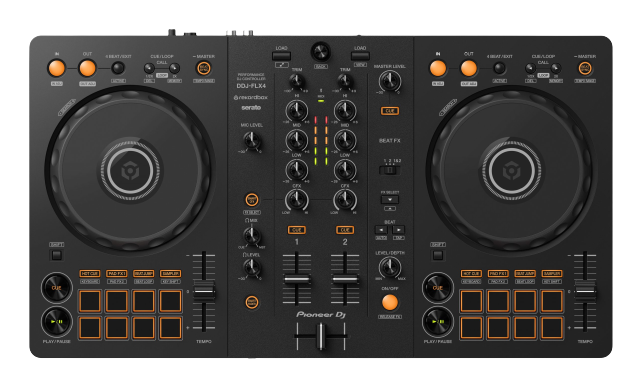
With a DDJ-FLX4, it has never been easier to start your DJ career, and the setup of this controller is very similar to Pioneer's top products.

Compared to the DDJ-200, there are more advantages and features on a DDJ-FLX4:
- Number of channels: 2
- Beat FX
- 8 Hot Cues
- Microphone input
- Master output (RCA: Phono Left & Right)
- Headphones output (mini-jack)
- Trim (channel level)
- Loops (in & out, 4 beat and call function)
- Comes with Pioneer's DJ software: Rekordbox DJ and Serato DJ Lite
- Pioneer DDJ-FLX4 controller is packed with cool features and effects
- Bluetooth 4.2
- Sold with a flight case

Disadvantages:
This DJ controller can do practically everything a DJ needs. The only major disadvantage is that you cannot use a USB if, for example, you have all your music stored on it.
For the Experienced DJ
CDJ 3000 X DJM-A9
If you're up to Pioneer's latest trend, then the CDJ 3000 players and DJM-A9 mixer are a huge go-to! This is the console that represents Pioneer's top-class product.
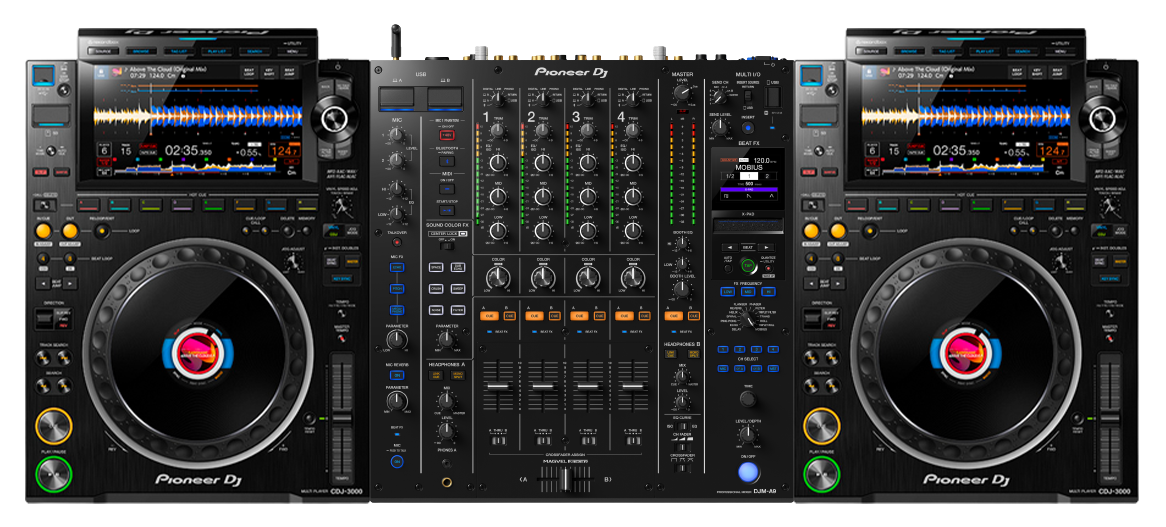
CDJ 3000 Player
There has been a revolutionary development in the CDJ collection over the last 30 years. The CDJ 3000 players have everything you dream of when playing as a DJ. There are a plethora of features and advantages, but among the most important are that it:
- Reads almost all hardware (hard drives, USB, SSD, SD, PC/laptop, etc.)
- Lightning-fast loading time
- 8 Hot Cues
- Loops (in & out, 4 beat and call function)
- Built-in screens, which are larger than its predecessor (CDJ 2000 NX2)
- Jog wheel adjust (hard and softness)
- Jog mode
- Master tempo and tempo
- Touch bar keyboard
- Search button
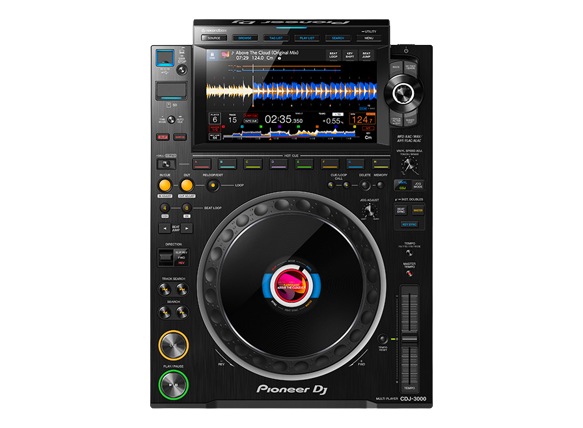
You can also connect the two players with a link cable into a switch along with the mixer, so when one player sends music from a channel, it lights up red, while the other, not playing music, lights up white. This way, you are never nervous about knowing which player is sending out music.
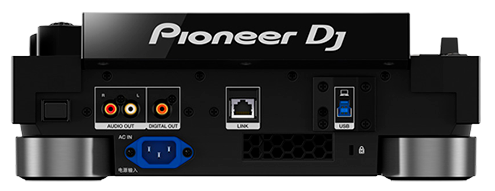
The CDJ-3000 needs a regular power cable to come to life. Additionally, it has an "audio out," where you can play music from the player alone using RCA phono cables without a mixer.
DJM-A9
DJM-A9 is a 4-channel professional DJ mixer that takes the standard for club mixers to entirely new heights.
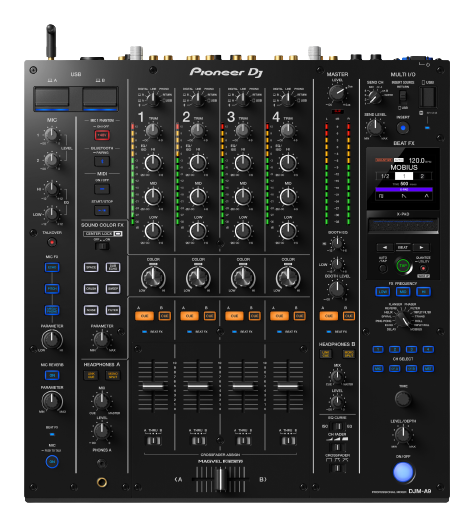
It is built much wider, and with it, you have much more space to work with. Some of the most important (and newest) specs are:
- Two computers/PCs can be connected at the same time
- Two outputs for headphones (ideal for B2B DJs)
- Center Lock
- Condenser microphones (+48V phantom power)

When comparing DJ controllers to the latest top products from Pioneer, there is no doubt that more expensive is also better. It's everything from features, size, speeds, to the user-friendliness of the product, which proves to be a huge contrast.
Recommendations
Regarding recommendations for each DJ, it must be said to be an enormously subjective opinion. If you are completely new to the field, it is recommended to step into a DDJ-FLX4, as it has a lot of features that a DJ should learn to get started properly. Also, if you, for example, want to play at a nightclub in the future, it is advantageous to choose DDJ-FLX4, as it has many of the features that Pioneer's top products from the CDJ collection can do.
If you are a more experienced DJ and have been playing for a few years, it will definitely be cool to have a complete console with CDJ 3000 players and a DJM-A9 mixer at home, but of course, there are a plethora of options where you can save money. It is recommended to invest in this complete console if you want top-class features or if you want to prepare a set 1-1 if the same console should be at a nightclub or a festival.
Remember the most important thing!
As mentioned, there are a plethora of differences in DJ instruments, but it is essential to separate what each one can do precisely and whether it is necessary to upgrade. Here is a list of the most significant differences in the shifts for the 3 consoles mentioned in the article. It gives you an overall picture of what you get out of your investment.
| Pioneer DDJ-200 | Pioneer DDJ-FLX4 | Pioneer CDJ-3000 + DJM-A9 |
| Advantages | Advantages | Advantages |
| Portable: weighs 1.2 kg. | Has sound output via RCA phono cables | Can read USB, SSD, SD, and PC/laptop |
| Compatible with smartphone | Can adjust trim/volume per channel | Wider and larger screen |
| Free app | Can connect headset | More control |
| Works with RekordBox | Portable: weighs 2.1 kg. | More buttons |
| 8 Touchpads/que points | Compatible with smartphone | More inputs and outputs for output |
| Transition FX | Free app | Greater comfort |
| Bluetooth | Works with RekordBox | Longer durability |
| Cheap | Cheap | Robust |
| Center Lock on filter | ||
| Two outputs for headset | ||
| Two PCs can be connected at the same time | ||
| Disadvantages | Disadvantages | Disadvantages |
| Cannot adjust trim/volume per channel | Does not read USB | Heavier in weight |
| Split cable for output | Less comfort | Higher prices |
| Less comfort | Fewer buttons | |
| Less control | ||
| Does not read USB | ||
| Cannot connect headset directly |
History - DJ Controllers - DJ Belmin
I started on the then Numark N4. The purchase was cheap and it was easy to start. After a few months, I saw a video of a very talented DJ, which I was extremely fascinated by. He could do some tricks on the then DDJ-SX that were not possible with the features Numark offered.
This was the reason why I sold my old DJ controller, switched to Pioneer's DDJ-SX, and from there, I got a more dedicated approach to the DJ world. I couldn't thank myself enough, as the purchase gave me the courage to make a lot of DJ videos, which later gave me a steady gig at the most popular nightclub in my hometown. Before my first night at the nightclub, I was extremely nervous because I knew I had to play on a CDJ 2000 console. It made me invest in a pair of brand new CDJ 2000 NXS players and a DJM-900 NXS mixer.
They have held up ever since, and now I want to invest in a single CDJ 3000 player, just for the reason that I can play music from 3 players at the same time, giving me room to make advanced mixes, live mashups, and edits. That way, I can make more videos and brand myself and my skills.
We hope you learned a little something new about the differences and similarities among DJ controllers, players, and mixers.
Enjoy starting and investing in your DJ career!



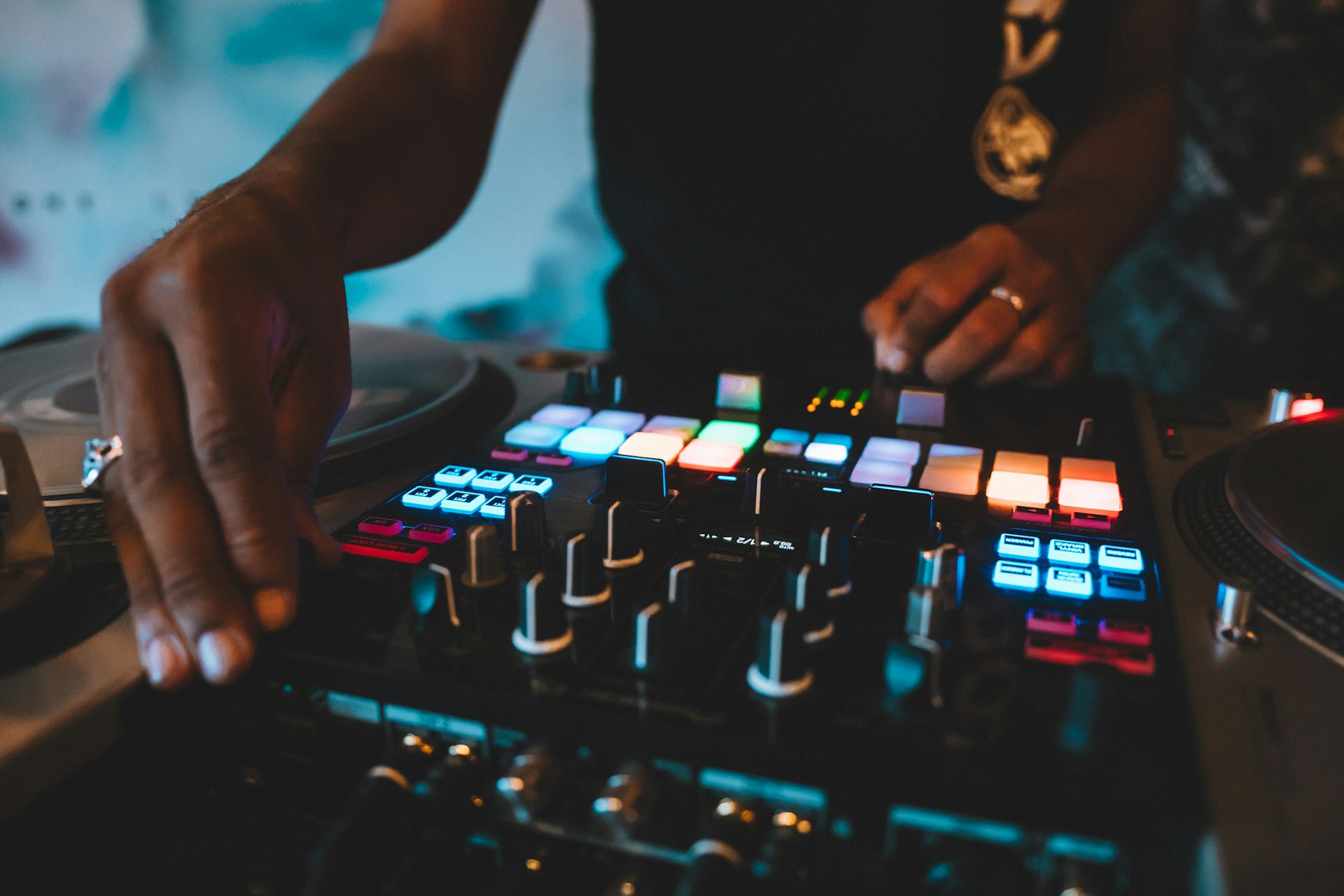

→ Back to our Information Center ←
Terms and conditions for private clients
Click here to see our terms and conditions for business clients
Music Group Denmark A/S and this e-commerce shop will be referred to as "seller, us, we, our, the webshop", while the client purchasing a product from Music Group Denmark A/S will be referred to as "buyer, client, customer, you, your, yours”.
Address:
Music Group Denmark A/S
Norddigesvej 4
DK-8240 Risskov
DENMARK
info@soundstorexl.com
Tel. +45 70273041
Private company
VAT: DK-33777175
Year of establishment: 2011
Delivery
The delivery costs depend on the size and weight of the order as well as the address and country of its destination. Please visit our Information Center for an updated country-specific price list. We reserve the right to charge the actual shipping price in case of goods exceeding the carriers' standard size and weight restrictions. We will inform the customer about this before the order is completed.
You have the option to enter an alternate shipping address, e.g. your workplace, when placing the order.
The sender of the package will be our logistics provider Online Distribution.
Please note:
When you order goods for private delivery, the order can be delivered by one or more carriers due to the fact that our suppliers use different freight companies. Packages will be handled according to the company’s method of conveyance.
You can find a list of our carriers in our Information Center. If you would like to know who will be delivering your order, in most cases you can find the information on Your Account. If this is not stated, please feel free to contact us.
Payment
In our e-commerce store you can pay with the following means of payment:
Credit cards
MasterCard
MasterCard Debit
Maestro
Visa
Visa Electron
The amount will not be drawn until we ship your order and we cannot draw a larger sum than the one you approved at the time of purchase.
Bank transfer
Please transfer the total order amount (including the delivery fee) to our bank Spar Nord Bank A/S:
BIC/Swift code: SPNODK22
IBAN: DK2290041120451932
We will charge no fees for banktransfers.
Gift certificate
Please note that you can only use one gift certificate per order.
For information on other country-specific means of payment, please click here.
When we have received the payment, we will ship your order immediately.
Prices
We reserve the right to cancel an order due to incorrect pricing in our e-commerce store (this might occur due to automatically calculated prices). The automatically generated confirmation, you will receive upon placing your order, is thus simply a copy of the online shopping cart - not our final order confirmation.
It is possible for you to view your previous orders in our online shop (starting from when you created a login with us). After logging on you can print your invoices etc.
Please note that both Danish and international private clients will be charged VAT according to Danish legislation.
Terms and conditions for discount codes and gift certificates
Unless stated otherwise, the following terms apply to the use of discount codes when placing a regular order (not applicable to individually prepared offers).
1. A discount code can only be used once per customer per day.
2. You cannot use more than one discount code per order.
A gift certificate is considered a deposit, not a product purchase. A gift certificate cannot be used as payment for a new one.
Right of return/cancellation
When shopping with us, you have 30 days right of cancellation. It expires 30 days after you:
When returning a product to us, please download our return form, fill it in and include it in the package.
Please note that some goods cannot be returned as normal cargo due to their size (this usually applies to goods over 30 kg or 2 meters in length).
You cannot cancel an order just by refusing to accept delivery without specifically letting us know.
Goods not included in the right of return/cancellation
We do not accept the return of demos and goods that have been made or ordered specifically for you (e.g. items that have been shortened according to your instructions or custom-made items). Furthermore, we do not accept the return of certain product categories, as it is impossible to assess the extent to which they have been used: pickups, pickup needles, bulbs, liquids, paint etc.
Return policy
Please use this return address:
Music Group Denmark A/S
Norddigesvej 4, Gate 6
DK-8240 Risskov
DENMARK
Please note that it is not possible to send us the goods COD.
We only accept products returned in their original packaging and only if the included software is not enabled. This means that when we receive the returned products, they must always be in minimum the same condition as when we shipped them. Therefore we kindly ask you to make sure that the item is properly wrapped. Since you are responsible for the goods until we receive them, we encourage you to keep your track and trace number from the carrier.
Please include a copy of the order confirmation or other documentation for your purchase when returning the item to us.
Please note that you are responsible for covering the shipping costs when returning a product to us.
In cases where the right of cancellation is used, we refund your purchasing price plus the delivery costs (if you had any when the goods were delivered to you) as soon as possible (and no later than 30 days from the day we received notification of your decision to cancel the order).
Please note regarding returned goods:
We always check goods returned to us, and you might lose your payment in part or in full. This happens if a product has been damaged or its value has been reduced. Among other things this could be the case for one of the following reasons:
Refund:
We make the refund with the same means of payment that you used for the original transaction unless we have explicitly agreed otherwise. If you paid with credit card, we will transfer the money back to the same card.
We can withhold the payment until we have received the returned item from you (unless you have submitted documentation for returning it). We refund the amount that you paid for the goods as soon as possible (and no later than 30 days from the day we received notification of your decision to cancel the order).
Read more about the cancellation of orders paid with MasterCard and Visa Card.
If the product is faulty (right of complaint)
When you shop in our e-commerce store you are protected by Danish legislation offering a high level of consumer protection. You have 12 months warranty and 12 months right of complaint which allows you to submit a complaint about errors or omissions that existed when the item was sold.
We do not provide support or warranty on free software (e.g. a trial or limited edition). The manufacturer provides the software support.
It is a requirement that the complaint is justified and that the defect has not arisen as a result of an incorrect use of the product or other damaging behaviour.
Please have a look at our Information Center for answers to frequently asked questions regarding this.
You are also very welcome to contact us. Depending on the specific situation we can tell you where the burden of proof lies, if the goods can be repaired or exchanged or if a discount can be an option.
Repair
If an error occurs with a product within the warranty period (12 months warranty from date of purchase + 12 months right of complaint), please contact us with a detailed description of the issue. Then we can arrange the details of the repair before you ship it.
Sending the product for repair consists of the following steps:
Fill in our online RMA form (repair form) to help us minimize the turnaround time.
Send it to us.
Await our answer regarding repair.
Send the product according to our instructions. We might ask you to send the product directly to the manufacturer to shorten the expedition time. Please note that it is not possible to send the goods COD.
When sending the package you MUST enclose:
An address to which we can return the product after repair
A list of the equipment included in the package, e.g. power supply
A copy of the original invoice (can be found in your customer account)
We will then get back to you as soon as possible.
Repair terms and conditions
The product must be sent securely wrapped, at best in its original box.
In case the stated error cannot be observed, or if the error has been caused by another product, an inspection fee of €55 including VAT is charged by invoice. The amount must be paid before the product can be returned to you.
Please note that you are responsible for covering the shipping costs when sending a product for repair. We pay the costs when returning the product to you after repair (only for private clients and only if the repair is covered by the warranty or right of complaint).
Personal Data Protection Policy
In order for you to enter into an agreement with our e-commerce store, we need the following information:
We solely register this personal information in our system for the purpose of processing your order.
No personal information recorded on our webshops will ever be transferred, sold or made available to third parties. All information is stored in a secure manner and is only available to our trusted employees.
Our e-commerce store has a highly encrypted and secure system for online payments to guarantee your safety when shopping with us.
The webshop system uses so-called cookies to manage the content of your shopping cart. In short, a cookie is the name of a file stored on the buyer's computer. We use these cookies to recognize customers and, for instance, remember what items are in the shopping cart when you shop with us. It is also possible for you to ask the system to store your contact details for your next visit. If you ever want to erase the information stored via cookies, this can be done in the browser settings. In Internet Explorer, for instance, please go to the "Tools" menu and then choose "Internet Options".
In addition, we register the IP address from which the purchase is made. This information is normally not used, but can be used in the case of a police investigation. The IP address is stored as long as necessary in relation to the police investigation. All fraudulent orders will be reported to the police!
According to Danish legislation the personal data are registered with Music Group Denmark and stored for five years after which the information is deleted.
When collecting personal information through our website, it is always done with your preceding consent. In that way you always know which information we have and why.
Our managing director and customer service employees have access to the information that is registered about you. The managing director of Music Group Denmark, Palle Bertelsen, is our systems manager.
When you are registered with Music Group Denmark A/S, you are always entitled to object to the registration. According to Danish legislation you also have the right to insight in the information we have on you. Please contact Music Group Denmark on info@soundstorexl.com regarding this matter.
Log entry
We use log statistics on our e-commerce store, which means that our system collects information that can give us statistics on e.g. the number of visitors, where they come from and where on our shop they drop out. Log statistics are used only for the purpose of optimizing our online shop.
You can choose to have your email address included on our mailing list. After registering you will regularly receive news and other information regarding our e-commerce stores. You may subscribe or unsubscribe this service at any time.
When you are registered with Music Group Denmark A/S, you are always entitled to object to the registration. According to Danish legislation you also have the right to insight in the information we have on you. Please contact Music Group Denmark regarding this matter:
Music Group Denmark A/S
Norddigesvej 4
DK-8240 Risskov
DENMARK
VAT: DK-33777175
Tel.: +45 7027 3041
info@soundstorexl.com
Complaints
If you want to complain of your purchase, please contact our customer service at info@soundstorexl.com or telephone +45 70273041.
→ Back to our Information Center ←